Ontario Animal Health Network (OAHN)
Poultry Expert Network
Quarterly Veterinarian Report
New PCR test now available at AHL for detection of Clostridium botulinum toxin genes and diagnosis of botulism
The AHL has developed a PCR to detect Clostridium botulinum toxin genes in liver and cloacal swabs. Please read this article for full details:
https://www.uoguelph.ca/ahl/detection-clostridium-botulinum-toxin-genes-pcr-new-test-now-available-ahl-diagnosis-botulism
Castellaniella: Are we missing this bacteria in lameness cases?
In the Fall 2023 issue of the Poultry Informed Professional newsletter from PDRC, there was an article describing isolation of Castellaniella from broiler breeders since 2018. They are initiating a research project to further investigate this bacteria that causes clinical signs of ‘tenosynovitis, femoral head necrosis, pericarditis and/or swollen wattles with submandibular edema’. When investigating broiler breeder lameness cases we can have difficulty obtaining good bacterial growth from obviously infected joints (good postmortem and histologic lesions) and it is unclear if this is due to previous treatment (no treatment history given). In discussion with Dr. Ðurđa Slavić (AHL bacteriologist), anaerobic culture must be ordered with aerobic culture to isolate this bacteria. Our routine is to order only aerobic culture due to cost and the number of samples we collect for lameness cases. In discussion with the other avian pathologists, if there has not been previous flock treatment for lameness, we would like to order anaerobic culture on at least 2 samples (i.e. joint swab) per case in order to determine if this organism is present. For postmortem cases of lameness, we will proceed with this approach starting February 1, 2024 unless veterinarians specifically indicate they are not interested in this testing. Please include flock treatment history when submitting lameness cases for postmortem examination. We will reevaluate the process as we go forward.
Fowl Adenovirus (FAdV, IBH), Infectious Bronchitis Virus (IBV), Infectious Bursal Disease Virus (IBDV) and Reovirus strains in Ontario (December 1, 2022 to Nov 30, 2023 – Q1 to Q4 2023).
Dr. Emily Martin and Dr. Davor Ojkic
In the OAHN year running from December 2022 to November 2023 the following tables show sequencing data from the AHL Virology lab for Ontario cases of FAdV, IBV, IBDV and reovirus. The most common field strains are highlighted in grey.



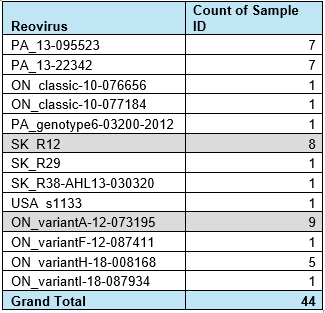
Poultry Veterinarian Survey Highlights – Q4 2023 (Sep-Nov)
Broilers
Early systemic bacterial infection (<14 d old) – ESBI
AHL: The number of cases were decreased from the previous 3 quarters. All cases had at least E. coli isolated either in pure culture or in combination with E. cecorum, or S. aureus.
Practitioners: Indicated as a commonly seen condition with stable to equally increased and decreased cases this quarter. Cases were attributed to Escherichia coli and Enterococcus cecorum.
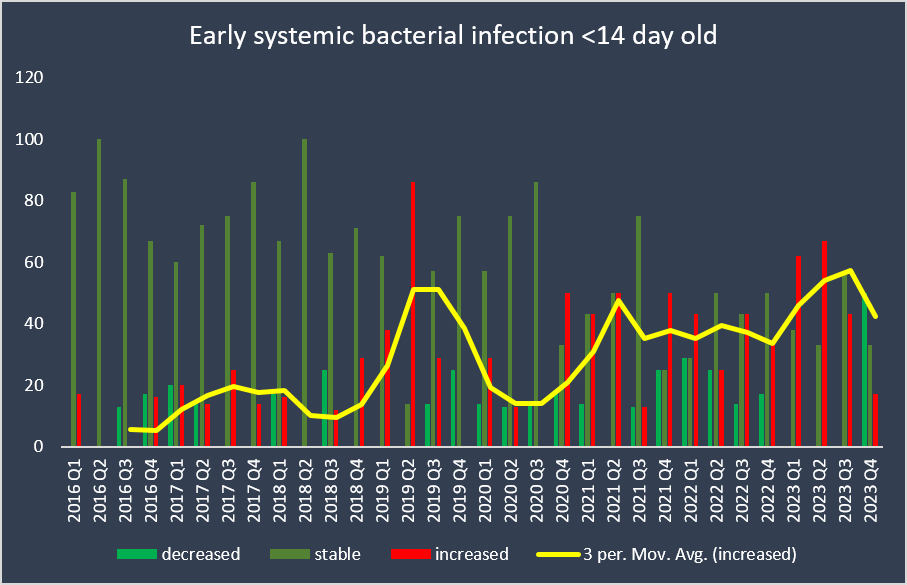
Other causes of early mortality (>14 d old)
AHL: No other causes of early mortality were identified this quarter.
Practitioners: Stable this quarter with spiking mortality syndrome, heart attack and dehydration as main causes.
Late systemic bacterial infection (>14 d old) – LSBI
AHL: The number of cases were decreased from the previous 3 quarters. All cases had at least E. coli isolated either in pure culture or in combination with E. cecorum, or E. cecorum and C. perfringens.
Practitioners: Reported stable numbers of infections with one respondent reporting decreased cases with E. coli, E. cecorum and P. aeruginosa listed as the main bacteria identified. Also, practitioners reported that between September and November 2023, 10-64 % of E. coli isolates were identified to be resistant to Trimethoprim sulfa (TMS).
Lameness – viral
AHL: The confirmed reovirus pathology cases were decreased from the previous 3 quarters but were increased from Q1 and Q3 2023. Fewer isolates were sequenced and from those that were sequenced the only strain identified was SK_R12. Reovirus suspicious cases (identified on histopathology) were increased from Q3 2023 but decreased from Q1 and Q2 2023.
Practitioners: Cases were reported as stable by practitioners with one veterinarian reporting decreased cases. The frequency of cases identified was mostly rare in the broiler flocks this quarter.
Lameness – bacterial
AHL: The number of cases were decreased compared to the previous 3 quarters. These cases were primarily diagnosed on histology. However, cases with bacterial culture identified S. aureus.
Practitioners: Reported as stable for this quarter with cases attributed to E. cecorum. This type of lameness was the most commonly identified condition in the flocks during this quarter.
Lameness – developmental
AHL: The number of cases were decreased from the previous 3 quarters with only 1 case of tibial dyschondroplasia identified.
Practitioners: Stable cases with mostly rare frequency or not seen this quarter.
Lameness – nutritional
AHL: The number of nutritional causes of lameness were the same as Q2 2023 (1 case of rickets).
Practitioners: Respondents reported stable incidences of nutritional lameness with rare frequency or not seen. One respondent mentioned an increase in cases during this quarter.
Ascites
AHL: No cases of ascites were diagnosed this quarter.
Practitioners: Reported as stable with equal number of respondents reporting rare to common frequency detection.
Coccidiosis and necrotic enteritis
AHL: The cases of both coccidiosis and necrotic enteritis were decreased from the previous 3 quarters. The majority of coccidiosis cases were identified in the small intestines.
Practitioners: Cases of coccidiosis and necrotic enteritis were reported as stable to slightly increased for this quarter with equal number of respondents reporting rare to common frequency detection.
Inclusion body hepatitis (IBH)
AHL: Cases identified on either histology or virus isolation were decreased from the previous 3 quarters. On Fowl adenovirus PCR, the most common species was FAdVE, however, FAdVD and FAdVAC were both identified on their own or in various combinations with FAdVE including all 3 species together. As in previous quarters, on sequencing the primary strain identified was FAdV08b (i.e., FAdV08b_AHL_16-049095_ON and FAdV08b_AHL_18-057921_ON). Viral isolation also identified FAdV08a_Stanford.
Practitioners: Overall, practitioners reported stable cases with one responder noticing decreased detection in cases this quarter. This condition was commonly observed in the broiler flocks this quarter.
Infectious bursal disease
AHL: The number of pathology cases as well as virus isolations were decreased compared to the previous 3 quarters. On sequencing approximately half are field strains (USA PA105-2014 field strain, USA Del-E field strain, and USA 66-Indiana-2014) and half are vaccine strains (USA D78, USA W2512-Blen, and UK Faragher 52-70).
Practitioners: Reported as stable to slightly decreased cases with equal number of respondents identifying this condition as rare or common during this quarter.
Infectious bronchitis (IBV)
AHL: The number of pathology cases were similar to Q3 2023 but the number of virus isolations was similar to Q2 2023. The primary strain identified was IBV_DMV_ON_21-017385 and the only vaccine strain identified was IBV_Conn.
Practitioners: IBV detection was reported stable to increased by equal numbers of the respondents and was identified as a common condition in the broiler flocks.
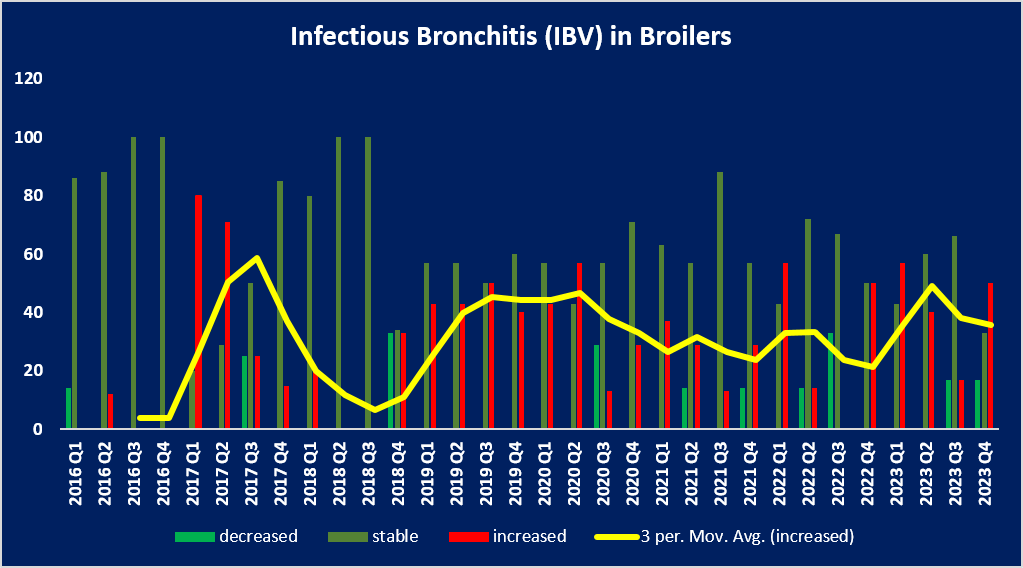
AHL: One case of spiking mortality was diagnosed on histology this quarter.
Practitioners: Reported as stable with one respondent reporting decreased cases for this quarter. This condition was described as rarely encountered in the flocks by practitioners.
Salmonella
Practitioners: Salmonella isolations were reported as stable to slightly decreased detections this quarter. The frequency of this condition is equally described as rare detection or not seen in the flocks by respondents. The most common serotypes isolated were S. Enteritidis, S. Kentucky and S. Kiambu.
Runting and Stunting Syndrome (RSS)
AHL: Confirmed and suspect cases of RSS (diagnosed on histology) were decreased compared to the previous 3 quarters.
Practitioners: RSS caused by astrovirus were reported as stable to slightly decreased cases. The frequency of this condition was described as rare to never seen by respondents.
Other diagnostic findings
AHL: Other diagnoses made at the AHL included cholangitis/cholangiohepatitis, tracheitis (environmental), and wooden breast.
Practitioners: No specific findings but described as stable by practitioners this quarter.
Condemnation issues
AHL: No condemnation cases in this quarter.
Practitioners: Issues were reported as stable with equal respondents stating increased or decreased issues for this quarter. Cellulitis was the most common cause of condemnations.
Slaughter provincial plants: The top condemnation conditions were reported as ascites, cellulitis and airsacculitis.
Slaughter federal plants: Subcutaneous conditions, abdominal oedema and liver conditions were reported as the main conditions for condemnation.
Broiler-Breeders
Fowl cholera
AHL: Occasionally isolated from lameness cases from vaccinated flocks.
Practitioners: Reported stable this quarter in vaccinated flocks with high culling rate and low mortality specifically affecting male birds. It was noted that this condition is responding well to antibiotic treatment based on susceptibility testing. Respondents state that frequency of cases is rare or never been seen in the flocks.
Early bacterial infection (<14 d old)
AHL: The number of cases decreased from last quarter to similar levels to Q2 2023. Cases had either E. coli isolated in pure culture or in combination with P. aeruginosa.
Practitioners: Reported as mainly stable with E. coli identified in the isolates.
Other causes of early mortality (<14 d old)
AHL: There was 1 case of dehydration/urate nephrosis and 1 case of myositis/myonecrosis with bacteria identified in this age group.
Practitioners: Reported as stable with rare frequency this quarter.
Prelay morbidity/mortality (<20 weeks)
AHL: The case numbers were similar to the previous quarter. Cases of septicemia had either S. aureus isolated in pure culture or combined with E. coli, or E. coli and E. cecorum. E. coli and E. cecorum were also isolated in combination. Another diagnosis included myocarditis.
Lameness – bacterial
AHL: The case numbers were increased from the previous 3 quarters. S. aureus was isolated in pure culture or in various combinations with E. coli, E. cecorum, and C. perfringens. Pure cultures of P. aeruginosa, E. coli, and E. cecorum or a combination of the latter 2 were identified. Cases of pododermatitis were slightly decreased from the previous quarter caused by mixed infections of varying combinations of E. coli, E. cecorum, and S. aureus.
Practitioners: Reported as stable to increased cases with common frequency seen in the flocks. Seeing a lot of lameness in males, especially when coming into production. This quarter, E. cecorum was the most common bacteria isolated but also E. coli, Staphylococcus aureus, Pasteurella multocida and Clostridium perfringens. It was noted that other conditions may contribute to this type of lameness such as genetics, mycotoxins, and exposure to stress related events (environmental pressure, fear and moving).
Lameness – viral, developmental and nutritional
AHL: Cases of reovirus (suspicious or PCR positive) were similar to the previous quarter. One sequenced case of reovirus revealed SK_R12. There was 1 case of tibial rotation.
Practitioners: All reported as stable by responders with rare frequency or not seen for this quarter. One possible case of lameness associated with reovirus SK_R12 strain but unclear of significance at this point.
Inlay bacterial septicemia
AHL: The number of cases were increased compared to the 3 previous quarters. The majority of cases have E. coli isolated in various combinations with E. cecorum, C. perfringens, S. aureus, and G. anatis with a maximum of 4 bacteria being isolated from one case. Other bacteria identified in pure culture included E. cecorum and S. aureus.
Practitioners: Septicemia was reported as stable this quarter with equal number of respondents reporting as rare or common condition encountered in the flocks.
IBV- decreased production/ abnormal eggs
AHL: One case diagnosed this quarter based on suspicious histologic lesions.
Practitioners: Reported stable cases with more than commonly seen in the field this quarter.
IBV – sudden spike in mortality
AHL: The pathology case numbers were similar to the previous 2 quarters; however, PCR positive cases were increased from the previous 3 quarters. Strains identified included IBV_Mass-H120 vaccine, IBV_Mass-MA5 vaccine, IBV_DMV_ON_21-017385, IBV_CA_1734_04, and CU82792.
Practitioners: Respondents were reporting stable cases with equal number of respondents describing as rare or common condition but mostly not seen in the broiler breeder flocks.
Disease related hatchability issues
Practitioners: Reported as stable condition with one respondent reporting increase in cases for this quarter. The majority of respondents stated that this condition was not seen in the flocks or was identified with rare frequency.
Mycoplasmosis
AHL: No cases of mycoplasmosis diagnosed this quarter.
Practitioners: Stable condition associated with M. synoviae with one respondent reporting decreased cases compared with the last quarter. This condition was not seen in the flocks or with rare frequency.
Necrotic enteritis
AHL: No cases diagnosed this quarter.
Practitioners: The number of necrotic enteritis cases were reported as stable. Equal number of respondents were stating that frequency of this condition was rare or was not seen in the flocks.
Coccidiosis
AHL: The cases were slightly decreased from the previous quarter and decreasing to similar levels as Q1 2023. Coccidia were identified in the small intestines (1 case with E. necatrix), ceca, or both the small intestines and ceca.
Practitioners: Generally stable number of cases reported. One respondent mentioned an increase in cases compared with last quarter. As for frequency, this condition was seen equally as common or rare in the flocks by respondents.
Fowl pox and ILT
AHL: No cases of fowl pox or ILT diagnosed this quarter.
Practitioners: Reported stable for this quarter.
Salmonellosis (clinical)/Salmonella isolation
Practitioners: Stable with a variety of Salmonella isolates including S. Infantis and S. Typhimurium.
Non-OHSFP with no detection on submissions.
OHSFP (environmental, cultures, boot swabs): 22 detections from 20 submissions. There were 8 serotypes isolated with the top 3 as follow: S. Kentucky (12/24); S. I:ROUGH O:r:1,2 (2/24) and S.Kiambu.
OHSFP (non-environmental samples EM Tissue pool) with 2 positive detections.
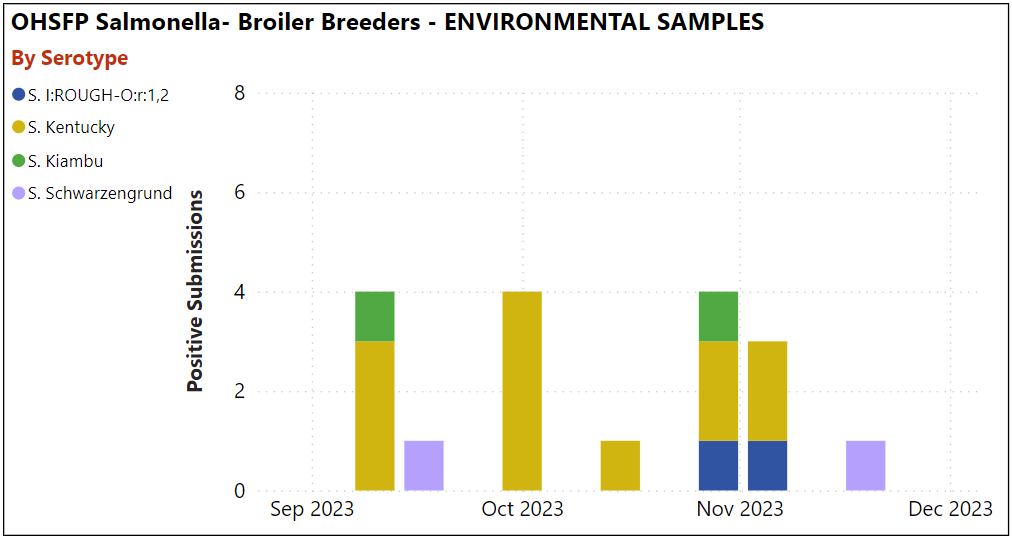
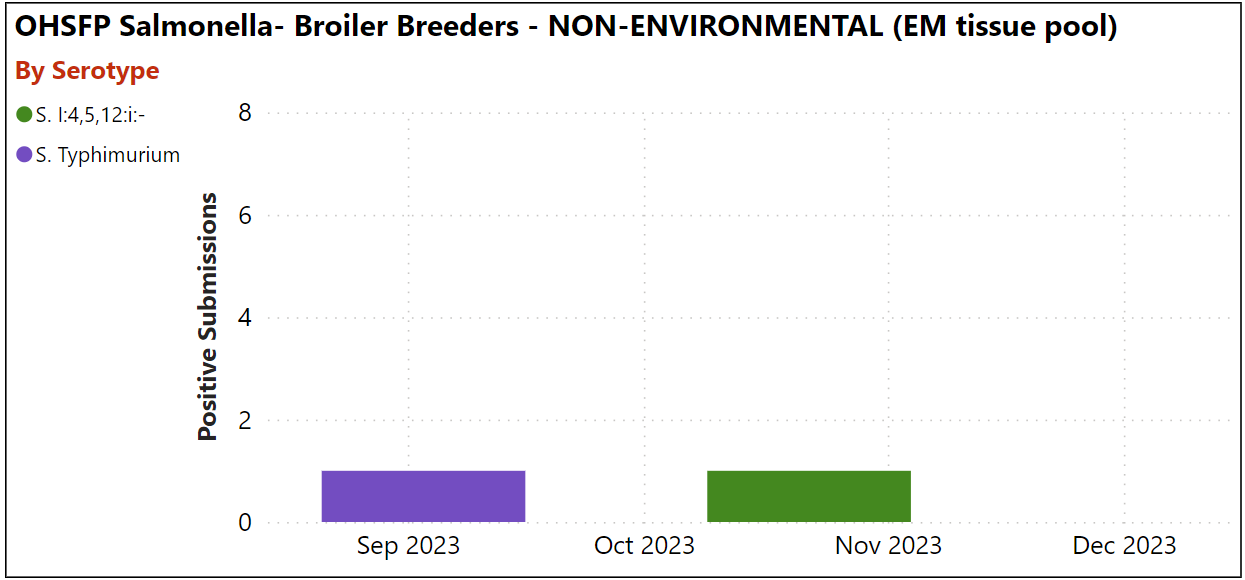
Aggression and cannibalism
AHL: Two cases of cannibalism diagnosed this quarter.
Practitioners: Cases were reported as stable with one respondent reporting increased cases (more male to male feather licking) compared with the last quarter. This condition was described as rare in frequency to never/not seen in the flocks.
Multi-drug resistant E. coli (resistant to >3 drugs)
Practitioners: Reported as stable.
Histomoniasis (blackhead)
AHL: Two cases of histomoniasis and 2 cases identified with Heterakis this quarter.
Practitioners: Stable cases reported by respondents. One veterinarian reported increase in cases compared with last quarter. This condition was described as seen with rare frequency or not seen in the flocks.
White Chick Syndrome
AHL: Two cases diagnosed this quarter. One case sequenced as CA-SK_19-0981_19.
Practitioners: Reported one case this quarter.
Other
AHL: Other diagnoses this quarter included gangrenous dermatitis (3 cases with various combinations of C. septicum, C. perfringens, E. coli, E. cecorum, and S. aureus isolated), salpingitis, neoplasia (lymphoid neoplasia, lipoma), suspect mycotoxicosis, vaccine reaction (neck), liver hemorrhage, and fungal pneumonia.
Practitioners: Five responders mentioned other cases as being stable.
Layers
The same as last quarter, veterinarians reported good, stable and solid health status for the past 3 months.
Osteoporosis
Practitioners: Stable condition. One responder reported decreased cases seen. The frequency of this condition was rare, and some respondents did not see it in the flocks this quarter.
Bacterial peritonitis/salpingitis
AHL: No cases diagnosed this quarter.
Practitioners: Stable cases with E. coli identified as the most common bacteria isolated in the layer flocks. The frequency of this condition remains rare to common status as with previous quarter.
Early systemic bacterial infection (<14 old) – ESBI
AHL: One case of omphalitis diagnosed this quarter.
Practitioners: Reported as stable to slightly increased. The frequency reported by practitioners was rare to not seen.
Other causes of early mortality (>14 d old)
AHL: No cases diagnosed this quarter.
Practitioners: Other causes of early mortalities were stable with equal numbers of responders reporting as rare to not seen in the flocks.
Prelay mortality (<20 weeks)
AHL: The number of cases were decreased compared to the last 3 quarters with 1 case of mycotic pneumonia diagnosed.
In-lay mortality (>20 weeks)
AHL: The cases of in-lay mortality are similar to the previous quarter. Diagnoses included hypocalcemia and salpingitis (E. coli, G. anatis).
Focal duodenal necrosis (FDN)
AHL: One case diagnosed this quarter (diagnosis made on histopathology).
Practitioners: Responders were reporting stable cases. Equal numbers of responders were reporting the frequency of this condition as common, rare or not seen in the flocks this quarter.
IBV- production drop/abnormal eggs and respiratory issues
AHL: Pathology cases were steady from last quarter and more cases were identified on virus isolation compared to last quarter. On sequencing the strains identified included IBV_DMV_ON_21-017385, and IBV_Mass-MA5 vaccine.
Practitioners: Stable cases reported by respondents. Most of the respondents were reporting rare frequency of this condition.
Salmonellosis (clinical) / Salmonella isolation
Practitioners: Reported as stable with one respondent seeing decreased cases. There were two early-stage flocks that were depopulated due to S. Enteritidis detection. Rodents are thought to be the source of infection making rodent control programs critical for Salmonella control.
Non OHSFP- no detection on submissions
OHSFP (environmental samples/cultures): 4 detections
OHSFP (non- environmental samples- fluff): 1 detection
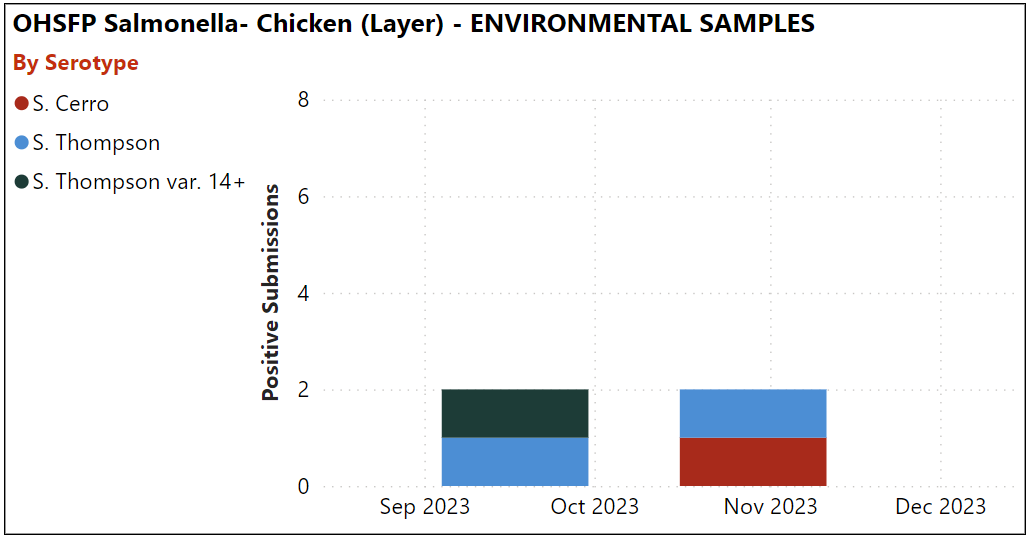

ILT and Mycoplasma
AHL: No cases identified this quarter.
Practitioners: Stable for both conditions with the majority of respondents stating that both conditions were not seen in the layer flocks during this quarter.
Coccidiosis and necrotic enteritis
AHL: Two cases of small intestinal coccidiosis and no cases of necrotic enteritis diagnosed this quarter.
Practitioners: Reported stable for both conditions with rare frequency noted by the respondents.
Aggression, cannibalism and hysteria
Practitioners: All reported as stable this quarter. The frequency of aggression and cannibalism conditions are commonly seen in the layer flocks.
Multi-drug resistant E. coli (resistant to >3 drugs)
Practitioners: Stable conditions that have not been seen by most of respondents or with rare frequency seen by few practitioners this quarter.
Histomoniasis (blackhead)
AHL: No cases diagnosed this quarter.
Practitioners: Stable conditions that was not detected this quarter by any of the respondents.
Other
AHL: Other diagnoses included bone fracture, hepatic lipidosis, and ventriculitis. One case IBDV PCR positive (USA 66-Indiana-2014).
Turkeys
Given turkeys have high susceptibility to HPAI, practitioners were pleased that no outbreaks have been detected since beginning of April 2023. A clear explanation could not be given but it is believed that enhancing biosecurity measures played a huge role in protecting the flocks against infection and transmission of this disease.
Fowl cholera and Erysipelas
AHL: No cases diagnosed this quarter.
Practitioners: Both conditions were reported as stable. Fowl cholera was not detected in the flocks and the frequency of Erysipelas was rare this quarter.
Early systemic bacterial infection (<14 day old) – ESBI
AHL: No cases diagnosed this quarter.
Practitioners: Mainly stable condition with equal number of respondents reporting increased and decreased cases. Streptococcus gallolyticus continues to be detected as the most common bacteria that affects especially females and it was associated with specific hatcheries. The other bacteria identified were E. coli, Pseudomonas and Salmonella spp. The frequency of this condition was reported as common to rarely seen in the flocks.
Other causes of early mortality (<14 d old)
Practitioners: Similar to the previous quarter this condition was reported as stable with slightly increased cases. The frequency was rare with equal responders reporting common to not seen in the turkey flocks.
Late systemic bacterial infection (>14 d old) – LSBI
AHL: The number of cases were slightly increased from the previous quarter. E. coli was isolated in all cases either in pure culture or in combination with E. cecorum, and Streptococcus gallolyticus.
Practitioners: The majority of the responders reported as stable with equal number of practitioners reporting increased or decreased cases detected. S. gallolyticus was the main bacteria identified by multiple practitioners to be responsible for LSBI. Once this organism is identified in flocks, repeat cases are seen on the same farm and in consecutive flocks. The frequency of this condition was mainly rare with few respondents reporting as commonly seen in the flocks.
ORT
AHL: One suspect case diagnosed this quarter (based on histologic lesions).
Practitioners: Stable condition with one respondent reporting increase in cases seen. Most respondents reported no detection of ORT in the flocks with two respondents reporting the frequency as common.
Mycotic and other respiratory disease
AHL: One case of mycotic pneumonia and multiple cases of bacterial pneumonia (based on histopathology) diagnosed this quarter.
Practitioners: Reported as stable this quarter. Responders were not identifying, or it was seen with rare frequency in the flocks.
Coccidiosis
AHL: One case of small intestinal coccidiosis diagnosed this quarter.
Practitioners: Stable to slightly increased cases with lesions mostly located on duodenum, jejunum and cecal segments of the intestines. The frequency of the cases seen were reported as rare to not seen with one respondent stating that cases were commonly identified this quarter.
Histomoniasis
AHL: One case of histomoniasis diagnosed this quarter.
Practitioners: The majority of the responders reported as stable with equal number of practitioners reporting increased or decreased cases detected. As far as frequency, this condition was identified as rare or not seen in the flocks.
Mycoplasma
AHL: No cases diagnosed this quarter.
Practitioners: Stable this quarter with no cases reported by responders.
Multi-drug resistant E. coli (resistant to >3 drugs)
AHL: Cases slightly decreased compared to last quarter. One case of coccidiosis (small intestine).
Practitioners: Stable to slightly increased condition with frequency of the cases seen reported as rare to not seen by respondents.
Necrotic enteritis and enteritis
AHL: No cases of necrotic enteritis or enteritis diagnosed this quarter.
Practitioners: Stable conditions with equal number of respondents mentioning increased or decreased cases. One respondent reported enteritis as common frequency, whereas the rest of the responders were equally reporting rare frequency to no such conditions seen.
Reovirus tenosynovitis
AHL: The number of pathology cases and virus isolations were slightly decreased from the previous quarter. Nine cases were diagnosed on histopathology. One other case had PA 13-22342 identified on sequencing.
Practitioners: Most of the respondents reported stable condition whereas there were equal numbers of practitioners reporting increased or decreased cases this quarter. One respondent reported viral tenosynovitis as commonly encountered, with the rest of the responders equally reporting rare frequency to no such conditions seen.
Round heart
AHL: One case of round heart identified this quarter.
Practitioners: Stable condition this quarter. Two respondents reported this condition as commonly encountered, whereas the rest of the responders were equally reporting rare frequency to no such conditions seen.
Aggression and cannibalism
AHL and practitioners reported no cases detected and stable for this quarter. One respondent reported this condition as commonly encountered, whereas the rest of the responders were equally reporting rare frequency to no such conditions seen.
Other
AHL: Other diagnoses included tibial dyscondroplasia, tenosynovitis (histology, E. coli/S. aureus), tracheitis/rhinitis, and ulcerative stomatitis/dermatitis/cellulitis.
Salmonellosis (clinical)/Salmonella isolation
Practitioners: Reported stable and S. Brandenburg was listed by one practitioner as the main isolate.
Non-OHSFP: One S. Typhimurium detection
OHSFP Salmonella isolated in turkey:
Environmental samples (environmental cultures, boot swabs, drag swabs): 56 detections from 48 submissions. There were 16 serotypes isolated and the top 3 serotypes were: S. Hadar (12/56), S. Brandenburg (9/56) and S. Uganda (7/56). There was one isolate of S. enteritidis this quarter (graph below).

Non-environmental samples (reactor, tissue pool, fluff): 3 detections of 2 serotypes from 3 submissions (see graph bellow)

Provincial slaughter plants: The top 3 condemnation conditions were hepatitis, peritonitis and airsacculitis.
Federal slaughter plants: The top condemnation conditions were subcutaneous conditions and emaciation.
Small Flock
Chickens
AHL: Diagnoses at AHL included intestinal parasitism (coccidiosis, nematodiasis), Marek’s disease, neoplasia (adenocarcinoma, soft tissue sarcoma, renal neoplasia), salpingitis, peritonitis, bacterial septicemia, pneumonia/airsacculitis, fatty liver hemorrhage, urate nephrosis/visceral urates, ILT (1 PCR positive), erysipelas, atherosclerosis, foreign body ventriculitis, necrotic enteritis, Mycoplasma gallisepticum, egg bound, and IBV.
Practitioners: The most common conditions seen were ecto and endo parasitism, ascites, Marek’s disease and other neoplasia.
Decreased cases of gastro-intestinal impaction, trauma, vent trauma, pododermatitis, and peritonitis/salpingitis
Stable conditions reported were: ecto and endo parasitism, Marek’s disease, other neoplasia, bacterial septicemia, pneumonia/airsaculitis, FLHS, urate nephrosis/ articular urate deposits, ascites, ILT, histomoniasis, erysipelas, toxin, and mycoplasma.
One ILT case reported this quarter in small flock with high mortality.
Gamebird
AHL: No gamebird cases submitted this quarter.
Practitioners: Gamebirds/ pigeons/ ratites: None of these species were reported to be physically examined during this quarter.
Duck
AHL: Two cases submitted this quarter.
1) Foreign body ventriculitis and visceral urate deposits.
2) Myoplasma anatis, septicemia (E. coli, P. multocida), and sinusitis (E. coli, P. multocida, Trueperella pyogenes, Strep spp., S. alactolyticus, Aerococcus viridans, E. cecorum, Rahnella aquatilis, Pseudomonas sp.).
Practitioners: No cases or flocks examined reported for this quarter.
Turkey
AHL: One case of cecal coccidiosis this quarter.
Practitioners: No information provided with the clinical impression this quarter.
Waterfowl
AHL: No waterfowl cases submitted this quarter.
Practitioners: Reporting the following conditions as stable: mycotic pneumonia, bacterial septicemia, intestinal conditions, parasitism, botulism, pododermatitis, peritonitis. There were reported decreased cases of toxicosis and neoplasia this quarter. The most common conditions: intestinal conditions, parasitism, and pododermatitis.
Poultry research from Ontario and beyond
- Investigation of risk factors for introduction of highly pathogenic avian influenza H5N1 infection among commercial turkey operations in the United States, 2022: a case-control study
- Investigation into the Cause and Prevention of False Layer Syndrome (uspoultry.org)
- Frontiers | A Poultry Subclinical Necrotic Enteritis Disease Model Based on Natural Clostridium perfringens Uptake (frontiersin.org)
- Influenza of avian origin in UK seal populations: qualitative assessment of the risk to the UK human population – GOV.UK (www.gov.uk)
Events and News
Poultry Industry Council events: https://www.poultryindustrycouncil.ca/events
Poultry Health Research Network information, events, and lectures can be accessed on the PHRN website: https://phrn.net/ or on the PHRN YouTube channel: https://www.youtube.com/user/PoultryHRN
Thank You!
We thank the following poultry veterinarians who completed the veterinary survey:
Dr. Elizabeth Black, Dr. Joanne Dias, Dr. Fernando Salgado-Bierman, Dr. Shahbaz Haq, Dr. Elana Huong, Dr. Kathleen Long, Dr. Anastasia Novy, Dr. Mike Petrik, Dr. Erin Preiss, Dr. Joanne Rafuse, Dr. Ben Schlegel, Dr. Chanelle Taylor, Dr. Brenna Tuer, Dr. Alex Weisz, Dr. Jessalyn Walkey, and Small Flock Veterinarians.


